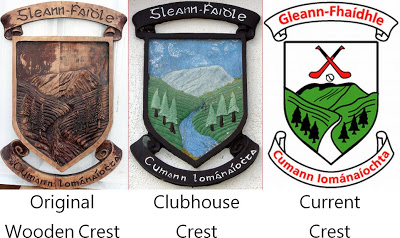A huge part of the history of any club is found inside the Club’s crest – a symbol every player carries on his chest with pride. An organised group is always symbolised and made unique by a few elements. Among the most important of these is the crest.

In 1982, when our Under 21’s had qualified for the County Hurling Final, the idea of a Club Crest was raised at a committee meeting. Paddy Staunton took the initiative and set about designing a crest which would be a unique symbol of Glenealy.
He asked local artist Pat Davis for assistance and drove into Wicklow town to meet him. As they returned together to Glenealy, he asked Paddy to stop the car on the outskirts of the Village and pointed to a sight that has now become well established as a symbol of our club – Carraig Mountain.
The Fir trees were added as a symbol of our long links with forestry. The meandering river is a reminder that, like life, most of the time it has to flow and some of the time it has to slow, but it will continue generation after generation.
In those days there was no Computer Aided Design, so the crest was sketched out and the services of a wood carver, Larry Ryan, were engaged. Paddy provided the wood from a Yew Tree felled on the grounds of The Old Rectory in Glenealy. Rumour has it that we were the first GAA club in the County of Wicklow to have a club crest.
In 1987, when the new clubhouse was built, it was decided to take a cast of the wooden crest so that a concrete one could be made for the entrance to the clubhouse. This was cast by Tony Barnaville, master craftsman in plastering and also a prominent club member. The crest was hand painted and set into the wall of the clubhouse with two crossed hurleys and sliotars at either side of it. This crest is still on view today.
In 2004, when O’Neills started to put crests on to jerseys, Michael-Anthony O’Neill (no relation to the clothing company) added the two crossed hurleys to the crest itself.
The spelling of Gleann Fhaídhle changed from the old Irish with the dot of lenition, eg Ḟ, instead of the h, eg Fh, to the spelling we all recognise today.

